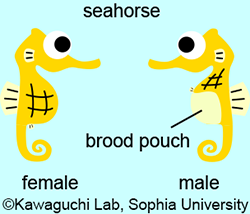Major Research Projects
Although the organisms possess common genes and use similar mechanisms, they have adapted to their respective environments, changed their gene functions, and diversified their morphology. Our laboratory conducts research on mainly two themes. The first is research topics using syngnathid fishes to clarify how genetic diversities brought the morphological diversities using morphology, physiology, and evolutionary biology techniques. The second is research topics regarding "hatching" to clarify how genetic diversity brought the diversity of protein functions, mainly using methods of biochemistry and evolutionary biology.
Formation of seahorse brood pouch

We first characterized how the brood pouch is formed in seahorses based on histological observations. Learn more about the formation.
Evolution of the brood pouch
The morphology of the syngnathid brood pouch is diversified. We examined various types of brood pouches. Learn more about the evolution.
Unique gene found in seahorse
We have been conducting RNA-seq analysis to investigate genes that produce characteristic tissues in seahorse brood pouches. As a result, we found a novel gene with no similarity to genes possessed by other organisms. As a result of examining its evolutionary process, we found that in the common ancestor of the genera Hippocampus and Syngnathus, elastin gene fragment was inserted into the genome either by retroposon or transposon, and obtained a novel function. This gene was expressed in seahorse-specific cells called flame cone cells. See the press release.
Sub-functionalization of the genes
Gene duplication is one of the important mechanisms for the emergence of novel genes. After the gene duplication, mutations occur. Although most of the genes become pseudogene due to the mutations, the gene may acquire a novel function. We are trying to clarify the evolutionary pathway of gene duplication using hatching as a theme. Learn more about hatching enzyme gene duplication.
Novel digestive enzyme in teleosts
Mammals, including humans, have stomachs, and pepsin is secreted from the stomach to digest food. In teleost fish, some fish have a stomach, while some do not. Therefore, the digestive mechanisms are diverse in teleosts. We discovered a digestive enzyme secreted from the pancreas, and named pactacin. The pactacin gene emerged by gene duplication of the hatching enzyme gene homolog. See more research on pactacin
Social Contribution
I also contribute to society through activities that stimulate intellectual curiosity. As part of that, I am creating fish illustrations. What kinds of fish are there and where do they live? how did it evolve? It is very important to know these information. For example, the points to be observed will change depending on whether the fish you find while diving in the southern sea is a seahorse or not.
Fish Illustrations
I have been using more than 50 species of teleosts so far. It is important for others to understand my research including what kind of fish it is. In order to display this, I have drawn illustrations and introduced the fish species used in my research. Sometimes, I draw requests from other researchers, and I draw some species to satisfy my own curiosity about what kind of fish they are. These fish species are summarized as an illustration page.
Periodic Table of Fishes
In order to study the evolutionary process of genes, it is necessary to understand the phylogenetic relationships of organisms. Teleost is the most diversified group in vertebrates, and their phylogenetic relationships are extremely complex, sometimes making it difficult to grasp their phylogenetic position. Therefore, I made the "Periodic Table of Fishes" by applying the classification and system of fish to the periodic table of elements that many people are familiar with. See the Periodic Table of Fishes
.